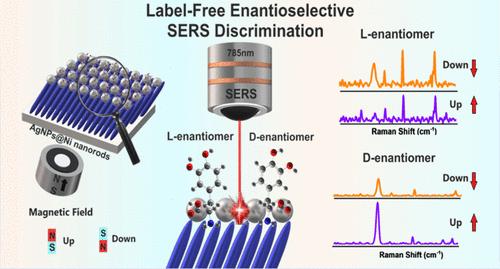银纳米粒子修饰的镍纳米棒阵列上自旋选择性电荷转移-SERS 驱动的手性分子无标签对映选择性识别
IF 8.2
2区 材料科学
Q1 MATERIALS SCIENCE, MULTIDISCIPLINARY
引用次数: 0
摘要
对映选择性鉴别在多个领域都至关重要,尤其是在制药和临床药物研究方面。手性分子具有独特的电荷转移特性,在与磁性表面相互作用时,电子自旋取向显示出对映体选择性偏好。在这里,我们开发了基于自旋选择电荷转移(SSCT)的无标记表面增强拉曼散射(SERS)非手性磁性基底,用于手性分子的对映选择性鉴别,而无需创建不对称的手性吸附位点。通过在镍纳米棒上装饰银纳米粒子,利用基于电子束的闪烁角沉积(GLAD)技术构建了非手性磁性表面增强拉曼散射(SERS)基底。对包括胱氨酸、丙氨酸和 DOPA(l-3-(3,4-二羟基苯基)丙氨酸)在内的重要对映体进行了 SERS 光谱分析。通过改变磁场方向,使用外部电磁铁操纵磁性基底的自旋极化。随后采集 SERS 光谱。根据磁场的方向,对映体的 SERS 光谱强度会发生互补变化。分子-金属复合物之间的 SSCT 过程与磁场方向协同控制电子自旋,从而实现了基于 SERS 的对映体选择性鉴别。这种无标记、简便而实用的方法为手性检测和分离提供了新的范式。本文章由计算机程序翻译,如有差异,请以英文原文为准。

Spin-Selective Charge Transfer-SERS Driven Label-Free Enantioselective Discrimination of Chiral Molecules on Ag Nanoparticle-Decorated Ni Nanorod Arrays
Enantioselective discrimination is critical in several fields, particularly in pharmaceutics and clinical drug research. Chiral molecules possess unique charge transfer properties, showing an enantioselective preference for electron spin orientation when interacting with the magnetic surface. Here, we developed spin-selective charge transfer (SSCT)-based label-free surface-enhanced Raman scattering (SERS) achiral magnetic substrates for the enantioselective discrimination of chiral molecules without creating asymmetric chiral adsorption sites. The e-beam-based glancing angle deposition (GLAD) technique was utilized to construct achiral magnetic surface-enhanced Raman scattering (SERS) substrates by decorating Ag nanoparticles over Ni nanorods. SERS spectroscopy was carried out on significant enantiomers, including cystine, alanine, and DOPA (l-3-(3,4-dihydroxyphenyl) alanine). An external electromagnet was used to manipulate the magnetic substrate’s spin polarization by altering the magnetic field’s direction. Subsequently, SERS spectra were acquired. Based on the magnetic field’s direction, there is a complementary variation in the intensities of SERS spectra of the enantiomers. The SSCT process between molecule–metal complexes synergized with the magnetic field direction to control the electron spin, leading to SERS-based enantioselective discrimination. This label-free, easy, yet practical approach offers a characteristic paradigm shift from the recent complex approaches for chiral detection and separation.
求助全文
通过发布文献求助,成功后即可免费获取论文全文。
去求助
来源期刊

ACS Applied Materials & Interfaces
工程技术-材料科学:综合
CiteScore
16.00
自引率
6.30%
发文量
4978
审稿时长
1.8 months
期刊介绍:
ACS Applied Materials & Interfaces is a leading interdisciplinary journal that brings together chemists, engineers, physicists, and biologists to explore the development and utilization of newly-discovered materials and interfacial processes for specific applications. Our journal has experienced remarkable growth since its establishment in 2009, both in terms of the number of articles published and the impact of the research showcased. We are proud to foster a truly global community, with the majority of published articles originating from outside the United States, reflecting the rapid growth of applied research worldwide.
 求助内容:
求助内容: 应助结果提醒方式:
应助结果提醒方式:


